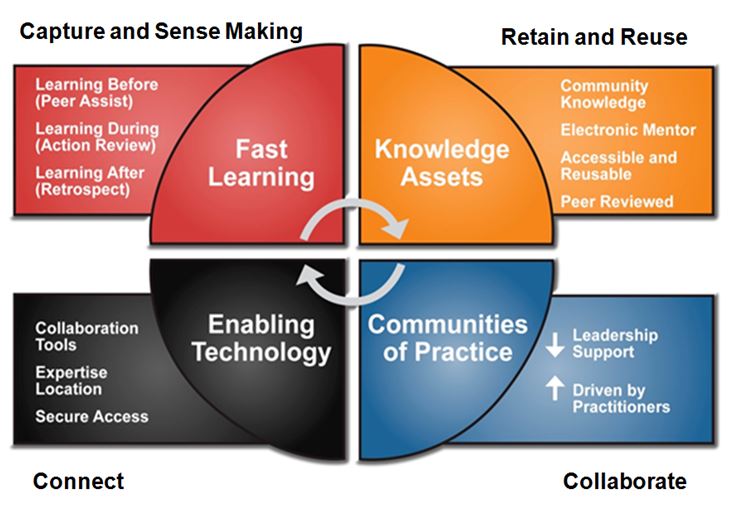Integrating Learning Processes, Communities of Practice, Knowledge Assets, and Enabling Technology

1. Learning Processes: The learning processes enable you to capture knowledge and make sense out of it before, during, and after you execute or deliver. These Fast Learning processes, part of an integrated behavior for learning lessons, contribute the content and the artifacts for the knowledge assets (knowledge repositories with knowledge artifacts) which store for easy access and reuse your information and experience.
2. Communities of Practice (COP): A community of practice is all about collaborative behavior. Some common understandings about CoPs are a group of individuals:
• who voluntarily come together for a shared purpose
• whose collective action significantly impacts individual performance
• whose ongoing interaction provides a sense of identity and a mechanism for mentoring and personal development
• whose interaction is expected to last while it serves their common purpose and enhances their relationships
Knowledge from your CoPs is harvested and characterized for reuse in your knowledge assets so that it can be re-used and adapted by fellow practitioners within that CoP or across your organization. Key to the success of communities is the support of the leadership in terms of time, investment, and resources to participate, maintain, and most importantly, sustain the communities.
3. Knowledge Assets: A simple way to describe a knowledge asset might be to call it a repository of knowledge or more accurately a “virtual mentor.” But it is really more multidimensional and dynamic than that when planned, constructed and applied effectively. Your knowledge asset could contain processes and methodologies, key insights, learnings and advice in the form of guidelines, checklists, effective practices and “first person told stories” in the form of short vignettes that clearly highlight critical learnings, insight or experience; and the business “context” in which the learning occurred and a link to the originator of the knowledge.
4. Enabling Technology: Enabling technology is the IT infrastructure and applications that enable “connection, collection and collaboration” from any location. This provides the means for accessing the knowledge and communicating effectively and efficiently across your organization, with your clients or customers, and with members of your community and others outside the community.
The path from concept, to strategy, to implementing practice will enable you to develop into a high performing and knowledge enabled organization reflecting some of the above attributes. You can evolve into a learning organization, one that not only captures lessons learned, but also “learns lessons” as you perform transferring those lessons across your organization.

